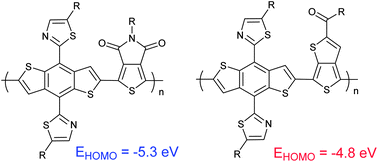Thiazolyl substituted benzodithiophene copolymers: synthesis, properties and photovoltaic applications†
Abstract
Three new conjugated polymers based on 5-decylthiazol-2-yl substituted benzodithiophene have been synthesized by Stille cross-coupling polymerization. 1,3-Dibromo-5-octylthieno[3,4-c]pyrrole-4,6-dione (M1), 2,5-diethylhexyl-3,6-bis(5-bromothiophen-2-yl)pyrrolo[3,4-c]-pyrrole-1,4-dione (M2) and 4,6-dibromo-thieno[3,4-b]thiophene-2-dodecyl carboxylate (M3) were used as acceptor building blocks for the synthesis of conjugated donor–acceptor polymers. The thermal, optical, electrochemical, and photovoltaic properties of the synthesized polymers were studied.

- This article is part of the themed collection: Flexible Electronics

 Please wait while we load your content...
Please wait while we load your content...